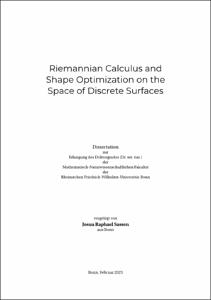Riemannian Calculus and Shape Optimization on the Space of Discrete Surfaces

Riemannian Calculus and Shape Optimization on the Space of Discrete Surfaces

| dc.contributor.advisor | Rumpf, Martin | |
| dc.contributor.author | Sassen, Josua Raphael | |
| dc.date.accessioned | 2023-07-27T14:44:19Z | |
| dc.date.available | 2023-07-27T14:44:19Z | |
| dc.date.issued | 27.07.2023 | |
| dc.identifier.uri | https://hdl.handle.net/20.500.11811/10960 | |
| dc.description.abstract | This thesis makes contributions to shape spaces and shape optimization of discrete surfaces. Discrete surfaces are triangle meshes with certain regularity and are ubiquitous in many applications in computer graphics, geometric design, and computational anatomy to name only a few. We consider the space of all immersions of a fixed discrete surface. Heeren et al. [HRS+14] used a physically-inspired metric derived from an elastic shell model to introduce the structure of a Riemannian manifold on this space resulting in the shape space of discrete shells. Rumpf and Wirth [RW15] introduced the time-discrete geodesic calculus used for this shape space. In this thesis, we show that this space can be represented as an implicit submanifold by considering the Nonlinear Rotation-Invariant Coordinates (NRIC) consisting of the vector stacking edge lengths and dihedral angles. To this end, we exploit discrete integrability conditions akin to the famous Gauß–Codazzi equations introduced by Wang, Liu, and Tong [WLT12], leading to the implicit description. Furthermore, we also show that NRIC are helpful to phrase and numerically solve geometric variational problems on discrete surfaces, especially if they involve isometry constraints. Based on the implicit representation, we propose a new method to construct submanifolds from shape datasets. We augment Principal Geodesic Analysis, an algorithm from Riemannian statistics, by a sparsity-inducing regularization leading to Sparse Principal Geodesic Analysis. The resulting sparse nonlinear modes of variation span a shape submanifold we can equip with a product structure based on decoupling modes. We propose two efficient parametrizations of this submanifold: One based on a grid-based multilinear interpolation of the Riemannian exponential map on individual factors combined affinely and one based on neural networks with an architecture and training procedure incorporating the product structure. These parametrizations are useful for (near) real-time applications in computer graphics, as demonstrated by numerical examples. Finally, we introduce a modification of the metric that moves surfaces with self-intersections infinitely far away from ones without. We will do so by leveraging the tangent-point energy, a repulsive nonlocal curvature energy for which Yu et al. [YBSC21] recently introduced an efficient discretization and numerical tools for its application in computer graphics. Our principal insight is that the graph of this energy over the space of discrete shells yields a metric as desired while retaining the appeal that geodesics provide physically-sound interpolations. This leads to the space of repulsive shells. We also propose numerical methods to compute geodesics and exponential maps on it. Additionally, we consider two shape optimization problems on discrete surfaces outside the realm of shape spaces. First, we introduce an approach to stochastic bilevel shape optimization that models, figuratively speaking, a design engineer optimizing shape parameters, a test engineer devising worst-cased load scenarios, and stochastic manufacturing inaccuracies. We develop numerical algorithms to compute solutions of the corresponding mathematical model and apply it to optimize thickness distributions on a discrete shell modeling roof-type structures. Furthermore, we consider a phase-field model for surface segmentation into equally sized parts with minimal interface length and distortion when conformally mapping the segments to the plane. To compute the distortion, we adopt the approach of Sharp and Crane [SC18] and introduce a diffuse version of the Yamabe equation used as a PDE-constraint. Finally, we discretize the resulting variational problems using finite elements and standard algorithms for nonlinear optimization. | en |
| dc.language.iso | eng | |
| dc.rights | In Copyright | |
| dc.rights.uri | http://rightsstatements.org/vocab/InC/1.0/ | |
| dc.subject | Formoptimierung | |
| dc.subject | Diskrete Flächen | |
| dc.subject | Formenräume | |
| dc.subject | Riemannsche Statistik | |
| dc.subject | Numerische Methoden | |
| dc.subject | Shape Optimization | |
| dc.subject | Discrete Surfaces | |
| dc.subject | Shape Spaces | |
| dc.subject | Riemannian Statistics | |
| dc.subject | Numerical Methods | |
| dc.subject.ddc | 510 Mathematik | |
| dc.title | Riemannian Calculus and Shape Optimization on the Space of Discrete Surfaces | |
| dc.type | Dissertation oder Habilitation | |
| dc.publisher.name | Universitäts- und Landesbibliothek Bonn | |
| dc.publisher.location | Bonn | |
| dc.rights.accessRights | openAccess | |
| dc.identifier.urn | https://nbn-resolving.org/urn:nbn:de:hbz:5-71506 | |
| ulbbn.pubtype | Erstveröffentlichung | |
| ulbbnediss.affiliation.name | Rheinische Friedrich-Wilhelms-Universität Bonn | |
| ulbbnediss.affiliation.location | Bonn | |
| ulbbnediss.thesis.level | Dissertation | |
| ulbbnediss.dissID | 7150 | |
| ulbbnediss.date.accepted | 25.05.2023 | |
| ulbbnediss.institute | Mathematisch-Naturwissenschaftliche Fakultät : Fachgruppe Mathematik / Institut für Numerische Simulation (INS) | |
| ulbbnediss.fakultaet | Mathematisch-Naturwissenschaftliche Fakultät | |
| dc.contributor.coReferee | Wardetzky, Max | |
| ulbbnediss.contributor.orcid | https://orcid.org/0000-0002-8069-4713 |
Dateien zu dieser Ressource
Das Dokument erscheint in:
-
E-Dissertationen (4119)




